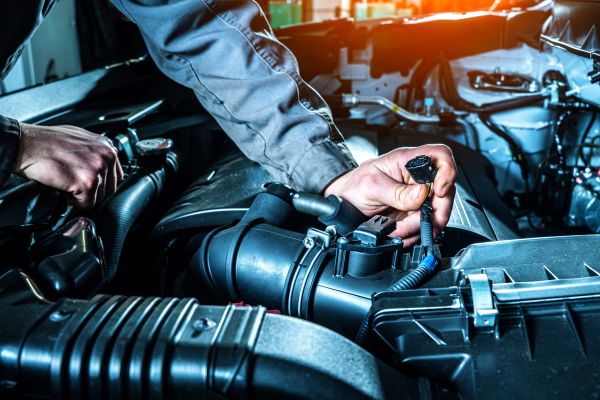If you want better handling or improved ride quality, start with upgrades to your stock suspension. This includes varying combinations of springs, shocks, bars and connections that take the weight of the chassis, engine, transmission and body placed over the wheels. These parts allow drivers to turn, brake and accelerate without road imperfections, big or small, rattling every bone in the body.
Connect with a verified mechanic in minutes. No appointments. No high fees. No waiting. Get back on the road and enjoy the ride.
Performance and comfort are often diametrically opposed notions; improve one and you reduce the other. Stiffening shocks will firm up the ride for more grip into corners. Adversely, a softer setup will wallow through potholes and bumps with ease but increase body roll. You can’t have both in the same car. Well, not without the help of air suspension kits.
The concept isn’t anything new. Citroen came up with ‘hydropneumatic’ suspension way back in the 1950s DS, and lowriders with similar hydraulic setups where a thing in 1970s American suburbia. The change from hydraulic fluid to compressed air reduced weight and complexity, provided more consistent results, increased longevity of suspension parts and more adjustability.
The Parts Involved
Air suspension resembles modern suspension systems, with the only change being that coils are replaced by air bags or bellows to take all the weight. These are made of reinforced rubber, similar to what you’ll see in tyres, and able to withstand extreme pressure. Airbags fit over performance rated shocks just like in coilovers and fitted with internal valves that aid in lifting and lowering the vehicle. Reinforced bracket plates affix the assembly to the chassis and wheel hubs.
Air is supplied to the airbags by way of an onboard compressor that is powered electrically, or by the engine. There’s also a separate air tank filled with pressurised air, and enough to lift the vehicle in a matter of seconds, and utilised for higher pressures. Air lines, often made of braided streel to prevent leakage, connect the tank to the airbags. Rated valves or solenoids ensure for a tight fit.
Air kits also include sensors that are either pressure or height based. Pressure sensors monitor the pressure in each bellow and inflate the air bags to the chosen air pressure. Height based sensors monitor the distance between the vehicle and road surface to do the same.
Connect with a verified mechanic in minutes. No appointments. No high fees. No waiting. Get back on the road and enjoy the ride.
Generally, with different loadings and weight distributed in different parts of the vehicle, height-based systems are what most buyers choose, as they are also more accurate in keeping the vehicle level. The information recorded by these sensors is relayed to an onboard controller, either manual and regulated by the driver, or self-adjusting and electronic. Electronic air suspension kits are those found as standard gear in high-end luxury vehicles and go by different names.
Why You’d Want an Air Suspension Kit?

Source: fastcar.co.uk
Want the same ride quality in your car as you’ll get from a Range Rover or Rolls Royce Phantom? These cars have air suspension as standard for a reason. In large SUVs and 4WDs, the ride height can be lowered or lifted to better suit the terrain. And often for each wheel separately. In luxurious road yachts, every minor or major imperfection in the road can be tamed for the utmost comfort.
Air suspension also lets you adjust parameters for better handling, more grip through the tyres, and more feedback through the steering wheel. Here they perform similarly, if not better to performance coilovers. Adjustment to camber or how the wheels are set relative to the road, and to castor or how wheels are angled in relation to the shocks and the rest of the car, means better cornering, more traction in aggressive braking and greater outright speed. Changes can be made to both front and rear axles, and for the specifics of different roads and road surfaces. Drivers can adjust air pressure in the air bags for a plush ride on pot-hole ridden backroads, or firm up the ride when doing laps around a track. And all this in the same car.
Besides increased comfort and better handling, an air suspension kit also helps by reducing tyre wear. Related is improved weight distribution (aiding handling), especially at the back axle. Loading vehicles to the brim, but still to the manufacturer’s recommended load limit, won’t lead to sagging rear ends. Sophisticated monitoring systems help in reducing wear in suspension parts, and many kits are rated to 120000 miles without issue. Driver’s will also notice improvements when towing. Firming up the rear suspension helps with the higher loads of bigger trailers, caravans and boats, so also adds to safety.

Review engine, brake issues, error codes and more with a Mechanic Online in just minutes.
Ask a Mechanic Live NowAre There Any Drawbacks?
Air suspension systems aren’t exactly cheap, but you’re definitely getting your money’s worth. Drivers of vans, lorries and utility vehicles can benefit from fitting air suspension only at the rear as this levels out the vehicle when loaded. Drivers with performance and handling in mind install full kits, and these are more costly. The added axle also requires bigger tanks and beefier compressors to push more air. There are additional hoses, wiring and sensors to monitor height and air pressure differences between rear and front axles and between different wheels. And more complex controllers to do all the maths.
All suspension types require regular maintenance, and air suspension is no different. With more parts, there’s the higher possibility of something going wrong. That’s why it’s important to source suspension parts from established brands (Air-Lift, Airrex and Odin as some of the better-known names) as these also offer warranties with rated mileage. The air bags and shocks themselves are robust and built to a standard, but there could be air leakage in hose lines, valves or faulty tanks. Issues like these though are usually inexpensive and easy to repair.
Can Air Suspension Be Fitted to My Car?

Source: carid.com
Cars that don’t have air suspension, even as factory fitted options, can nevertheless have an aftermarket kit installed. There’ll be minimal work required, as air suspension parts take the place of stock shocks and springs and each kit is engineered and tweaked for the specific vehicle. Air tanks can be placed in the boot, or under the carriage along with compressors and sensors fitted at each wheel. Manually adjusted systems can have physical buttons in the dash or centre console to adjust each air bag or the rear and front axles separately, depending on what you choose.
Air suspension kits are available for performance cars, commercial vehicles and everyday drivers. All will gain better handling, including increased traction, cornering, acceleration and reduced braking distances. Overall comfort will be significantly better, as the vehicle literally glides over road imperfections.
Max Anthony
Max is a gizmo-savvy guy, who has a tendency to get pulled into the nitty gritty details of technology and cars. He attended UT Austin, where he studied Information Science. He’s married and has three kids, one dog and a GMC truck and a Porsche 911. With a large family, he still finds time to share tips and tricks on cars, trucks and more.
Review engine, brake issues, error codes and more with a Mechanic Online in just minutes.
Ask a Mechanic Live Now




